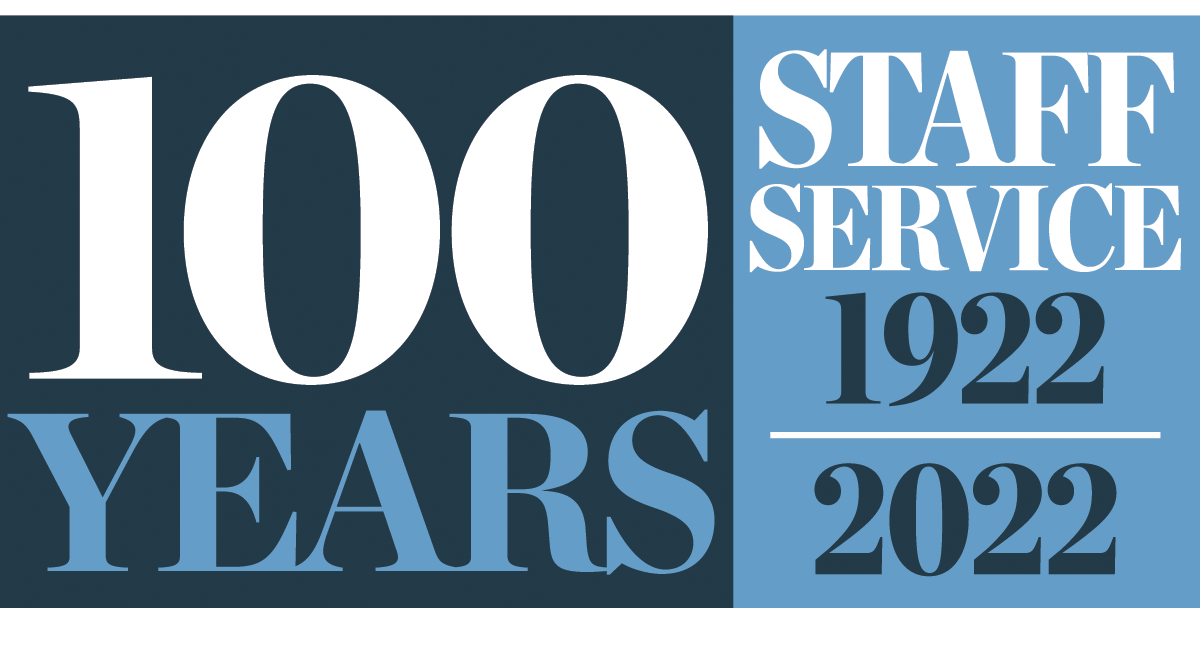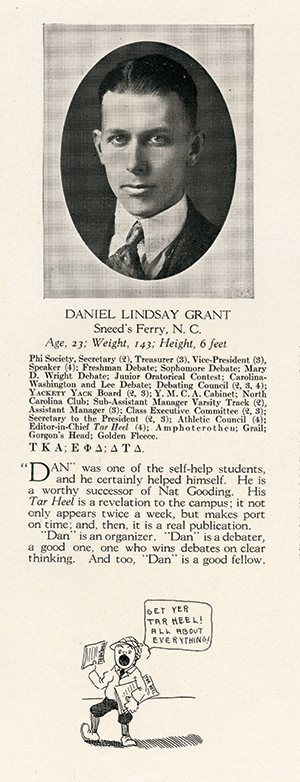The GAA Gets Professional
Posted on May 31, 2022 This is part of a series on the 100th anniversary of the GAA hiring its first full-time, paid professional staff member for an organization that for 80 years prior had been run by volunteers.
This is part of a series on the 100th anniversary of the GAA hiring its first full-time, paid professional staff member for an organization that for 80 years prior had been run by volunteers.
A century ago this spring, UNC’s General Alumni Association appointed Daniel Lindsay Grant (class of 1921) its alumni secretary, the association’s first full-time paid professional.
The June 1922 issue of what was then called The Alumni Review published Grant’s first column as secretary. He used the space to make an appeal for support for the University, whose graduates at the time were almost exclusively men.
“The University produces men,” Grant began his message. “These men in turn produce a greater University than that which produced them. Thus, an unending cycle enlarging, enriching and deepening the lives of both the University and her alumni at its every revolution.”
Gov. John Motley Morehead (class of 1817) and 30 other alumni gathered at Commencement in 1843 to start an alumni association. Some chapters sprung up in ensuing years, and, in 1881, alumni made their membership official by paying $1 in annual dues.
Since its founding, the GAA had been run by volunteers keeping track of alumni, raising money and publishing a magazine. E.R. Rankin (class of 1913, 1914 MA) had been part-time secretary “without one cent of compensation,” the Review wrote. Hiring a professional administrator represented a deliberate effort to strengthen and speed up the quest to enable the University, as Grant ends his column, “to maintain its high prestige in the nation, and to turn out year by year generations of greater and greater men.”

The 1921 Yackety Yack entry for Daniel Lindsay Grant (class of 1921), an organizer, debater and good fellow (at 6 feet tall and 143 pounds).
At the same time, the GAA board established a separate Central Alumni Office, which Grant set up to create a firm boundary between the University and the alumni association. Grant, who had been editor of The Daily Tar Heel his senior year, took over as editor of The Alumni Review, which Louis Round Wilson (class of 1899) had been managing since the magazine’s founding in 1912.
Grant had been secretary to UNC President Harry W. Chase prior to coming to the GAA. He became the first of only four men to have led the alumni association in the past century.
By the time the Review resumed publishing in October 1922 after its summer hiatus, Grant had laid out his eight-point plan for an alumni program. First on the list: “Finding University men.”
The GAA had current addresses for only half its 11,000 alumni at the time. Grant had in mind publishing an updated “alumni catalogue,” which “should be rushed to completion,” he wrote in his October column. He wanted to find a way to finance hiring staff to keep alumni records. He aimed to increase the circulation of the alumni magazine; it went to only a third of the alumni at the time. He planned to form more than 100 local alumni chapters nationwide. And he also hoped to write a history of the roles that University graduates played in the Spanish-American and “great world wars.” More work needed to be done, he noted in his column, with “the record of our men in the Civil war.”
The first Alumni Catalogue was published in 1889, through the efforts of Cornelia Phillips Spencer. Grant published his version, Alumni History of the University of North Carolina (1795–1924), in 1925, and it included biographical data, along with each alumnus’s current address. The roster listed not only the 11,000 living alumni, but the 4,000 deceased. The next edition wasn’t published until 1954 and was henceforth called the Alumni Directory.
In the foreword to his Alumni History, Grant wrote that he wanted the tome to “be more than the recitation of individual successes and failures to grace or shame us, more than a book to be pushed to the most unused corner of a bookshelf … .”
From the start of his tenure, Grant seemed to understand that an alumni association is in the relationship business. He set his rudder to enhance the connection between alumni and their alma mater. And he recognized the importance of the University giving back to the state that funded it. In his debut column as secretary, he never once mentioned money. Instead, he advocated: “Public service, accomplished through fine men, is the first and great mission of every educational institution.”
Fundraising was almost an afterthought. Although “Financing the secretary’s office” came in at No. 5 on his inaugural program outline, Grant mentioned only in passing “several incomplete or incipient alumni projects,” among them finding the money to the build big-ticket items of Graham Memorial Hall and The Carolina Inn.
Grant was initially elected for a two-year term, and when that ended, he was elected for a four-year extension. He left the position in October 1927, a year before it was to end. He had been awarded a two-year grant by the Carnegie Corp. to move to New York to study alumni relations.
But he didn’t leave the GAA in the lurch. His exit came at “the completion of the task of organizing the work of the Association,” he wrote in his resignation letter. During his tenure, the GAA’s Central Office moved from Alumni Hall to South Building. In 1926, Grant was named president of the American Alumni Council. That same year, he wrote the 205-page Handbook of Alumni Work that detailed the services of the alumni office and the functions of the association.
After he left the GAA, Grant remained active in fundraising for Carolina, and he received the GAA’s Distinguished Service Medal in 1983. He died in 1989 at age 91.
— Nancy E. Oates
